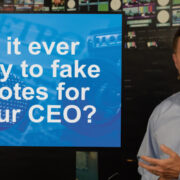Is Social Media Mandatory, Optional, or Useless in a Crisis?
 By Gerard Braud
By Gerard Braud
Public relations professionals are appalled at the suggestion of taking a social media site dark and they tweet back to me the names of brands that they think could never go dark in a crisis. But that isn’t the question nor is it why I sparked the debate. The question is, what is right for YOUR brand or corporate social media page?
One size does not fit all in social media policy.
In this article, I will review some important highlights from a podcast I did with Shel Holtz exploring whether there is ever a right time to take your social media sites dark during a crisis. You can listen to the entire podcast here.
1) The entire world on social media is not your primary audience in a crisis. If the crisis garners coverage by the mainstream media, rapid communications to your employees with simultaneous rapid communications to the media should be done first.
In this excerpt I discuss why tried and true beats shiny and new when it comes to social media and crisis communications.
2) Just because you, as a corporate communications or public relations professional, wear out your thumbs scrolling through social media all day, doesn’t mean the rest of the world does. Study the demographics and digital habits of your audience, employees, and customers. There are many companies for which the executive staff, board members, and many of the employees still don’t use social media. E-mail is often more effective than a post on Facebook or a Tweet.
In this excerpt I discuss it further.
3) Be bold enough to consider whether your social media site should go dark because your crisis is being complicated by nasty comments by certified crazies. Many of you who subscribe to this blog are a communications and PR team of one. You have no one else on the PR staff. You should focus on the audiences that are most important and the communications channels that are most reliable. All companies should place high value on their secure website and direct e-mails to their employees and customers. Those loyal employees and customers will become your advocates and supporters on social media.
I discuss which types of brands could go dark without their audience noticing and which types of high profile brands would likely have to stay up and endure an assault of negative comments.
4) Monitoring social media in a crisis is crucial. But don’t waste time getting sucked into the vortex of trying to be a therapist who “listens” to everyone who has a comment. Don’t get sucked into the vortex of trying to respond to everyone, positive or negative. If possible, identify high-value negative stakeholders and comment that you will call them on the phone to have a human-to-human conversation. If you see that your platform is being overrun by the social media trolls, be aware of what they say, but know when to “ignore the mean kids on the playground” and focus on your core audience.
In this excerpt I discuss when you need to let the naysayers have their own discussion on their own social media site, rather than polluting your site.
In conclusion, remember that no two crises are the same and when it comes to social media, one size does not fit all.
This final excerpt looks at what you should do to prepare, long before your darkest day.
Crisis communications and media training expert Gerard Braud, CSP, Fellow IEC is based in New Orleans. Organizations on five continents have relied on him to write their crisis communications plans and to train their spokespeople. He is the author of “Don’t Talk to the Media Until…”
More crisis communications articles:
3 Lessons the Melania Trump Coat Can Teach All Public Relations People
The Biggest Lie in Crisis Communications
4 Steps Every Company Needs to Take in Order to Avoid the Default Spokesperson



Leave a Reply
Want to join the discussion?Feel free to contribute!